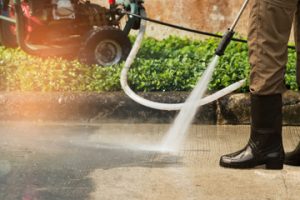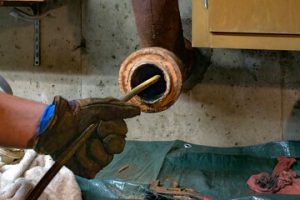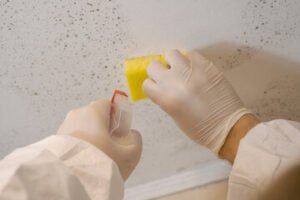Power Washing Services is a fast, effective way to remove accumulated dirt and grime from outdoor surfaces. This includes building exteriors, sidewalks, parking lots and more.

Incorrect use of a power washer can lead to damage. Professional power washing services will know how to adjust the pressure settings and nozzles to avoid damage.
Power washing is a great way to get rid of mold, mildew, dirt, and grime buildup on surfaces. It also helps to prevent deterioration and damage to surfaces from water, sun, wind, and snow. Regular power washing of your home, driveway, patio, and deck can improve curb appeal and make your property look newer and better maintained. It can also help to extend the life of your siding, paint, and other exterior surfaces.
Hiring professional Power Washing Services is the best way to ensure that your property is cleaned thoroughly and correctly. They have the proper equipment to handle high pressure and temperatures, as well as the right cleaning products for different surfaces. They can also use techniques like soft washing to clean your home without causing any damage or leaving any residue behind.
A dirty-looking exterior can leave a bad impression on guests and potential buyers. If you are planning to sell your property in the future, it is important to keep it looking its best. A regularly-maintained exterior can increase your home’s value and add to its curb appeal. It is also important to clean the exterior of your business or commercial property regularly to avoid damage and deterioration.
When hiring a power washing service provider, be sure to check their credentials and experience. Look for a company that has experience with various types of surfaces and is licensed and insured. It is also a good idea to ask for references and reviews from past customers. These can give you a sense of the quality of work that the company provides and how satisfied their previous clients were with their services.
While DIY power washing may seem tempting, it can lead to expensive damages if not done properly. Inexperienced homeowners can easily damage the surface of their homes or commercial properties by using the wrong cleaners or applying too much pressure. A professional power washing service will have the necessary experience and expertise to clean a variety of surfaces without damaging them. They can also recommend the best cleaning products and techniques for each type of surface, as well as offer advice on how often your property should be cleaned.
Safer Environment
Power washing is not only effective at cleaning a variety of surfaces, but it is also an environmentally friendly way to clean. The high-pressure water used in power washing can effectively remove dirt and grime from hard to reach areas that are often neglected. This process can also help to restore exterior materials like asphalt, concrete and brick by removing mold, mildew, and other contaminants that may cause damage over time.
Many people assume that power washing is dangerous because it involves a hose that creates a powerful stream of water. However, when professional power washing services are used, the equipment is operated by trained technicians who know how to use it safely and efficiently. They also take the proper precautions to protect themselves from harm caused by the high-pressure water stream, such as wearing safety glasses and gloves.
Additionally, using the correct pressure settings is vital when it comes to power washing. This ensures that the surface is cleaned thoroughly without causing any damage or weakening of the material. Professional power washing services have the knowledge and expertise to properly clean a variety of different surfaces, including siding, decks, patios, driveways, and sidewalks.
Regular cleaning with power washing prevents the build-up of moss, rust, and other pollutants that can compromise the structural integrity of exterior surfaces. In addition, it helps to reduce the amount of dirt and debris that is blown into the environment, which can harm wildlife.
Commercial properties that are regularly power washed can make a great first impression on customers and encourage repeat business. Power washing is an essential part of establishing a professional image and maintaining a welcoming environment for visitors and employees.
Commercial properties often need to be power washed to remove dirt, mud, oil stains, and other substances from parking lots, walkways, and building exteriors. The process can also be used to remove graffiti, gum, and oil stains from surfaces that are difficult to clean. Regularly scheduled power washing services can keep these areas looking their best and create a safer environment for guests and employees.
Increased Property Value
Many people think of home improvements when it comes to increasing property value, but a quick and easy way to improve your house’s worth is through power washing. This service helps remove dirt, grime and stains on exterior surfaces to make them look new again. This boost in curb appeal can increase your property’s value and help you sell it faster.
One of the most important things to remember is that a home buyer’s first impression of your property is formed by its curb appeal. Power washing helps your property to be more attractive and appealing, resulting in a higher sale price and making it easier for you to sell.
Another important reason to power wash is that it can help prevent damage and deterioration to your property’s siding, shingles, concrete and more. Things like mold, mildew, moss and algae can degrade your siding if left untreated. Regular power washing can stop these contaminants from growing and can save you money in the long run.
Power washing can also be used before you repaint your home or business. This ensures that the paint will stick and last longer. In addition, it will keep the chemicals and materials used in your paint safe from the water pressure.
In the end, a professional power wash can help preserve your home and make it look new again. This will prevent the need for costly repairs and replacements and can save you time and energy in the future.
There are many ways to improve your property’s worth, but most of them involve large projects that can take a lot of time and effort to complete. Power washing is a fast, easy and affordable way to increase your property’s value and help you get more out of it when it comes time to sell. Contact us today to find out more about our residential and commercial power washing services. We serve homes and businesses in Scarsdale, Putnam County and Westchester.
Increased Home Value
If you want to increase your property value, then it’s time to think about adding some power washing services to your routine. Professional power washing makes your home look new and fresh, which is a big selling point when it comes to homes on the market. It also shows potential buyers that you care about your home and are committed to keeping it looking its best.
A dirty and unkempt property can make a potential buyer feel like they’re walking into a pigsty. Regular power washing keeps your home, driveway, roof and outdoor spaces clean and sanitary, which is an indicator of how well you take care of your home and can make them want to pay more for it.
Besides boosting your curb appeal and making your home look nice, power washing also helps to protect your investments. Harmful contaminants such as mildew, mold and algae can cause damage to exterior surfaces if left untreated. Regular power washing prevents these harmful substances from building up, which reduces maintenance costs and extends the lifespan of your exterior surfaces.
When compared to the cost of replacing siding, shingles or concrete after they are damaged, investing in power washing is a wise decision. Moreover, hiring professionals to perform the cleaning can help you avoid any safety risks associated with using a power washer as well as minimize repair expenses.
Power washing your property can also eliminate fungi that may be hiding under the surface of your property, which can cause health issues for you and your family members. Fungi can trigger allergic reactions and respiratory problems, which is why removing them early is essential for your wellbeing. Using the right pressure settings and attachments to remove stains effectively without damaging different types of materials is key to the success of your power washing.
Do-it-yourself power washing can be an affordable option, but it’s important to remember that a lack of knowledge about the equipment and proper techniques may lead to physical harm or property damage. Hiring a professional is the best way to ensure safe and effective results, as they will be familiar with the best methods and tools for your specific needs.



